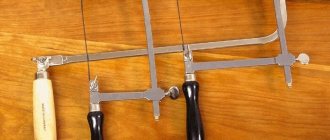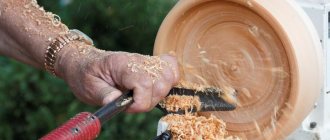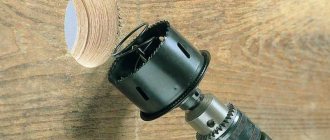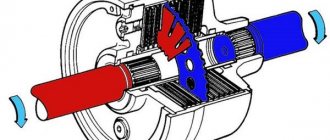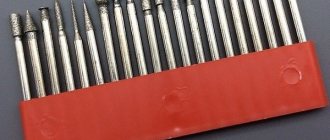The abundance of modern machines has not caused the disappearance of hand tools from workshops. Independence from the availability of power supply, the possibility of use in field conditions and other advantages do not allow traditional devices to leave the arsenal of professionals and amateurs. One of the most popular types is the hacksaw. Everyone needs it - owners of private houses, gardeners, lovers of wood crafts and many other craftsmen. Let's take a closer look at this topic.
What is it and what is it for?
A hand saw is a saw blade, the working part of which is equipped with a notch of teeth. On one side there is a handle, holding it to make reciprocating movements. At the same time, the teeth come into contact with the material being processed and saw it in a given direction. A hacksaw is primarily designed for working with wood, although there are special varieties for cutting metals, plastics and other materials.
Despite its main purpose, it is not recommended to cut wood derivatives (chipboard, MDF plywood, etc.) with a regular hacksaw. The teeth become dull quickly and require sharpening. To cut these materials, special tools with carbide tips or hardened teeth are used.
The purpose of a hacksaw is to cut (sawing) materials. It cannot perform any additional functions, but it copes with basic tasks perfectly. The cutting process is the same for all materials, although the quality of the blade is different in each case. The tool is convenient for performing work in the field, has a compact size and light weight, which allows you to take it with you on hikes or trips.
Etymology
It is believed that the basis of the word saw
comes from the Proto-Slavic language
*pila;
from where also white.
pila
, Ukrainian
and Bulgarian saw
, floor
рiɫа
, Czech.
pila
, Slovak
and Slovenian pila.
It is assumed that the word came into Slavic languages by borrowing from Germanic languages (cf. ancient German
fîla, fîhala
(“file”), ancient Saxon
fîla
, English
file),
which is related to Greek.
πείκω
(“scratch”, “cut”, “scratch”),
πικρός
(“sharp”) and ancient Indian.
piṃc̨áti
(“cuts down”)[1].
Types, features, purpose
A hand saw is used to work with wood. However, its tasks do not end there. There are a large number of tasks - from clean cutting of small elements (adjusting glazing beads or platbands, sawing out precise parts) to rough cutting of logs or boards into pieces. All these issues are resolved using different types of hand tools, which have their own characteristics and capabilities.
Expert opinion
Levin Dmitry Konstantinovich
A specific feature of most hacksaws is the position of the blade. It is free and is held in a given plane only by the metal’s own elasticity. Sometimes this becomes the reason for marriage. To strengthen the blade, a backing saw was invented (with a reinforcing element installed on the upper edge of a wide blade), to a bow saw (with a blade stretched between two support strips, pulled together at the top through a spacer). In addition, there are saws with thick blades that have increased rigidity and resistance to lateral loads.
All varieties are designed to perform specific tasks. For a clean cut, choose a tool with a small (mouse) tooth; for longitudinal or transverse sawing, there are different methods for sharpening the teeth. There are also universal types that can perform a large number of operations. Home craftsmen usually choose such hacksaws, and they come with special models designed to solve special problems.
TOP best models
The TOP 5 modern hand saws for wood are represented by the following models:
- Bahco 2600-16-XT11-HP. The saw copes equally effectively with transverse and longitudinal cuts. The canvas has a special coating against friction forces. Equipped with resistant teeth and an ergonomic non-slip handle. Weighs less than 0.5 kg. The only negative is the high price.
Hand saw for wood Bahco line Source insales.ru
Advantages and disadvantages of the tool
The positive qualities of hacksaws include:
- Simplicity and relative safety of use.
- The ability to cut any materials that do not exceed the hardness of the metal blade.
- Compact, light weight, easy to use.
- No special training is required to use the tool. The necessary skill comes in just a few minutes of work.
- A large number of varieties and models.
- Possibility of restoring functionality (sharpening, wiring) with your own hands.
The disadvantages of hacksaws are:
- The result of the work depends on the experience and skills of the master.
- The need for periodic setting and sharpening of teeth.
- The ability to cut materials depends on the quality of the metal of the hacksaw.
- The canvas has to be protected from mechanical influences, in particular from bending or breaking the surface.
- The metal is susceptible to corrosion, from which the tool must be protected.
Expert opinion
Levin Dmitry Konstantinovich
Despite the existing disadvantages, the use of hacksaws is not becoming more rare or forced. Any master always has a hand tool, with which, if he has the skills and experience, he can perform precise and clean operations.
You may be interested in: Cordless reciprocating saw. How to choose, rating of the best models
Video description
Video on how to choose the right hacksaw for wood:
- Stanley Jetcut 2-15-283. This hand saw model was included in the rating of hacksaws for wood as the best among universal ones. Thanks to the 3-sided sharpening of the teeth and a fairly long blade - 45 cm - the tool allows you to saw almost any workpiece without clamping. Disadvantage: the cut is not of very high quality and is not suitable for processing finishing parts.
- BAHCO LAPLANDER 396-LAP. Folding universal saw. Application – construction, tourism, hunting, fishing, gardening. The universal shape of the teeth allows you to cut wood both lengthwise and crosswise. Canvas length 23 cm.
Note! When choosing a saw, it matters how often it will be used. For periodic use, a model with hardened teeth is suitable; for frequent use, it is better to use one made of standard steel, since inevitable grinding will require constant updating of the cutting part, which cannot be done with an analogue made of hardened material.
Classification
There are several varieties designed to perform individual tasks. They are divided into groups according to different characteristics.
By type of canvas:
- Narrow . Used for cutting out various shapes with a relatively large radius of curvature of cutting lines.
- Regular . This is the most common type of saw, has a standard blade width and is designed to perform different jobs.
- Obushkovaya . These tools have a wide blade with fine teeth. Capable of performing clean cuts with high precision. Used for precise, critical work using a template or pre-applied markings. A special feature of backed hacksaws is the need to process material that is obviously thinner than the blade - the presence of a backing will prevent it from being passed through the cut.
- Luchkovaya . A narrow sheet with a small tooth is stretched between two support bars. This design combines several capabilities - clean, neat cuts, cutting accuracy and high productivity.
By type of tasks performed:
- Classic . It is used in most situations when it is necessary to saw off a piece of board, saw through timber or solve other issues of a common nature.
- Trimming . Used to adjust elements protruding above the plane. The handle of such a saw is placed in such a way as not to interfere with the blade coming into contact with the material along its entire length. A special case of a scoring saw is the abutment construction. This group also includes tenoning and edging saws.
- Circular . The narrow blade allows you to make figured cuts. You can cut a closed contour by starting work from a pre-drilled hole. The free end of the blade is not secured, which requires caution during operation—it is easy to bend or deform the saw with a careless movement.
- Plywood saw . It has a wide blade that allows you to hold a straight cut without the danger of taking it to the side. The teeth at the beginning of the blade allow you to start cutting from the middle of the plane.
- Award . This saw is capable of performing specific tasks - cutting grooves and other structural elements. It has several handles, and the method of operation is closer to the method of processing with a plane. Requires skills and experience from the master.
- Folding saw . Typically, such a tool has a handle that is detached or rotated, making the overall length of the hacksaw noticeably shorter. Convenient for a hike, trip or other field conditions.
There is a separate group of tools - Japanese saws.
The traditions of carpentry in this country require virtuoso mastery of the instrument, the quality of which has been elevated to the level of art. The technique of working with Japanese saws cannot be repeated with a conventional hacksaw, since the elasticity of the blade and the ability to maintain shape and plane are used.
The names of the tools are little familiar not only to beginners, but also to experienced specialists:
1-Kataba 2-Ryoba 3-Dozuki
- Kataba . A saw with teeth on one side of the blade. It has a universal sharpening that allows you to perform both longitudinal and cross cuts.
- Rioba . The blade of these tools is equipped with teeth on both sides of the blade, and on one edge there is a notch for longitudinal cutting, and on the other - for cross cutting.
- Dozuki . The flexible blade is designed for precise and accurate cutting. in the area of the handle, the teeth become smaller, which is convenient for performing critical work.
- Mawashibiki . A narrow blade with fine teeth, capable of producing fine and clean work.
A common feature of Japanese hacksaws is their relatively small size and specific method of use. Unlike European tools, which are effective when moving away from you, Japanese saws are all designed to move towards you. This is unusual at first, but experienced people testify to the significant advantages of this technique.
Story
The saw is one of the oldest tools. Small, often flint, tools were used already in the Neolithic era (7-3 thousand years BC). Stone saws had a solid blade or a blade made up of separate elements. Also in ancient times, flexible rope saws and toothless ones with a free abrasive were used. Saws made from obsidian, sea shells and shark teeth were also used[2].
Copper saws appeared in Ancient Egypt (circa 3100-2866 BC)[3]. Many copper saws were found in grave No. 3471, dating from the reign of Djer (31st century BC).[4] According to Chinese legend, the saw was invented by Lu Ban[5].
Saws allowed improvements in woodworking. The carpenter's saw was known to the Minoan civilization of the Bronze Age. Saws are mentioned in the Old Testament (Is. 10:15). The Etruscans were famous for their bronze saws.
The first iron saws were invented by the Scandinavians. Saws were cast in stone molds. However, due to their low quality, such saws could not compete with axes.
Many centuries later, in Ancient Greece they began to make saws using the forging method, which made it possible to achieve high metal hardness and, as a result, improve the quality of products[6].
In ancient Greek myths, the invention of the saw is attributed to Talos, the nephew and student of Daedalus[7][8]. About iron saws ( serrae
) mentioned by Thomas Aquinas in the Summa Theologica (III, 74, 2)
In 1926, a mechanical chain saw based on an electric motor was patented, and in 1929 the first chainsaw appeared[9].
- The sun god of the ancient Babylonian pantheon (far right) with a handsaw
- Bronze saw of the 17th century BC. e. from Akrotiri. Thira Museum of Prehistory
- Painter and carpenter in a fresco from the tomb of Nebamon and Ipuca (c. 1350-1300 BC). Ancient Egypt
- The saw in the illustration is ca. 1425
- Sound effect recording in the 1930s
- Performer on a musical saw on the street of Prague
How to choose your instrument: selection options
The main indicators of the instruments are:
- Canvas length . To perform precise work, small tools with a working base of about 30 cm are used. More productive and efficient results can be obtained by using a hacksaw with a blade of 45-55 cm. In this case, the path of the working edge along the workpiece increases, increasing the cutting speed;
- Web width . This indicator demonstrates the stability of the saw when performing precise work. The wide base allows for more precise control of the vertical, which ensures a clean and straight cut;
- size and type of tooth sharpening. The size of the teeth is determined by the degree of cleanliness of the cut - the more precise it is, the smaller the size and distance between the elements of the notch. The sharpening method allows you to obtain a blade designed for longitudinal sawing (triangular teeth with apexes directed forward), cross-cut (notch in the shape of an isosceles triangle), and a universal type (triangular apexes are slightly ground off for softer contact with the part);
- Wiring . To reduce friction and heating of the blade, the tops of the teeth are alternately deflected from the plane by a certain amount. Modern tools immediately go on sale fully prepared for work, but on old hacksaws the wiring has to be updated as the notches are ground down. If there are carbide brazings, wiring is not required, since their thickness is greater than that of the blade;
- The grade of metal from which the tool is made . The stronger and stiffer the canvas, the more freely the master works with it. Increases productivity and quality of sawing;
- Type and angle of inclination of the handle in relation to the cutting edge . This indicator refers to the organoleptic properties of the instrument. A comfortable handle, installed at the correct angle to the working edge, allows the worker to more confidently control the direction and quality of cutting the material, spend less effort and get a more effective result;
- Saw blade material . The harder the metal, the fewer problems with the cleanliness and accuracy of the cut. Steel from 45 HRC is considered the norm, but harder grades 55-60 HRC can provide increased operational reliability. Some hacksaws have an additional Teflon layer, which eliminates friction and heating of the blade during operation.
Some indicators can be perceived subjectively - it may be more convenient for users to work with a non-standard tool, this is normal, for each master the blade can be slightly modified (the sharpening is changed, the handle is rotated, etc.).
Notes
- Vasmer, Max.
Saw // Etymological dictionary of the Russian language. - M.: Progress, 1987. - T. 3: Muse-Syat. - P. 261. - 832 p. - P. d'A. Jones and E.N. Simons, "Story of the Saw" Spear and Jackson Limited 1760-1960 Archived June 26, 2013.
- Walter B. Emery Excavations at Saqqara, The Tomb of Hemaka and Hor-Aha
, Cairo, Government Press, Bulâq, 1938 (2 vols) - Archived copy (undefined)
. Access date: January 15, 2016. Archived February 25, 2016. The 1st Dynasty Tombs of Saqqara in Egypt by John Watson - Lu Ban and The Invention of the Saw Archived February 4, 2011. History Anecdote at Cultural China website
- History of the saw - History of things (Russian). Access date: January 13, 2020.
- Ovid. Metamorphoses. VIII, 236-259.
- Ovid Metamorphoses Bk VIII:236-259: The death of Talos Archived February 17, 2011.
AS Kline translation, Electronic Text Center at University of Virginia Library - proinstrumentinfo.ru.
The very first chainsaw in the world. Lumberjacks' Joy | About Instrument (Russian). proinstrumentinfo.ru. Access date: January 13, 2022. - ↑ 123
Saws // Commodity dictionary / I. A. Pugachev (editor-in-chief). - M.: State Publishing House of Trade Literature, 1959. - T. VI. - Stb. 1028—1038 - Netyksa M. A.
Workbench. Saw. Axe: Fundamentals of carpentry and turning. Lessons from an old master. - M.: RUDN, 1994 Publishing house of RUDN, 1994. - 40 p.: ill. - ISBN .. - pp. 12-28. — 40 s. — ISBN 5-209-00899-2. - Mendelevich I. R. Carpentry and joinery works. - M.: Stroyizdat, 1950.
Saw alligators
The alligator saw is an interesting type of tool with a reciprocating mechanism. It uses two cutting blades at once, moving in a support rail in counter motion to each other.
Saw BOSCH GFZ 16-35 AC
Thanks to this, the tool works easily, without jerking and vibration typical of, say, a reciprocating saw, the sole of which must be pressed tightly against the surface being processed. The alligator saw is a fairly powerful and productive tool; in terms of the range of tasks it is close to reciprocating saws.
DeWaltAlligator saws are used to cut a wide variety of materials.
Bosch
The long bar allows you to cut thick logs.
Briefly about the main thing
A hand saw allows you to efficiently, quickly and safely saw wood, as well as materials based on it and analogues with similar characteristics. When choosing a tool, the following parameters are taken into account:
- Purpose.
- Size, pitch, type of teeth.
- Type of fabric material.
- Length and shape of the canvas.
- Type of handle.
There are the following types of saws for wood: classic, narrow, with a back, bow, award, folding. The TOP 5 best models included: Bahco 2600-16-XT11-HP, Gross Piranha 24109, BISON EXPERT, Stanley Jetcut 2-15-283 and BAHCO LAPLANDER 396-LAP.
Ratings 0

